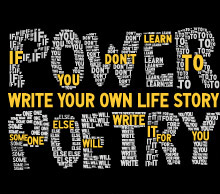Epiphany
I don’t like poetry.
I know, it sounds like blasphemy to an English teacher’s ears but
I just don’t like it.
I know, I sound like a six year old
who doesn’t want to do what she’s told
and wants to do what she wants but
it’s the truth.
I mean, I just don’t see the big deal.
Who cares if this color means something,
or if this object represents something else;
Why can’t blue curtains be blue
simply because the author’s favorite color is blue?
Did we really have to analyze that?
Did that really mean something,
or are English teachers really just
making up some nonsense
that we’ll never really need in life?
Really,
What.
Is.
The.
Big.
Deal?
Then the worst part comes:
“Write your own poems! We want to see what you can do!”
Oh boy.
Here we go.
I’m not a writer,
I’m an artist!
What makes you think I can write a poem?
I’d rather bang my head repeatedly against the keyboard.
Can’t I just go into a quiet room
and add some reds, blues, and yellows to a white canvas?
Can’t I just go take a pencil and sketch what I think I actually look like,
or splash some trees onto a blank piece of paper?
Okay. I’ve relaxed now. I got over my temper tantrum. Concentrate.
I’m reading the words to this stupid poem.
The words aren’t THAT stupid. The poem isn’t THAT stupid.
My headache is starting to fade away. I think I’m getting it now.
Oh.
Yes, I think I’ve got it now.
It all makes sense.
It’s starting to click.
The author is like an artist.
The way he weaves words together,
quietly,
sophisticated;
It’s like looking at a piece of abstract art.
You look at it and wonder,
“Why is THAT in a museum? Is that really art? I don’t get it,”
and think maybe you should move onto the renowned painting
with swirling blues and yellows and twinkling stars
that is drawing a crowd
just because that’s the only piece that
anyone in the whole museum has actually heard of.
But you still stare at the abstract piece.
You look at it,
thinking,
why would an art museum
hang a plain white canvas with nothing on it
except for a dot here with a line over there?
What is the big deal?
Why did the artist think that what he did was any good?
What do the dot and the line mean?
There must be a reason for it!
I guess this is the same process that English teachers go through.
Maybe it’s not all nonsense.
Maybe the author of the poem wanted to get us to think,
to make us see that there is a reason for everything.
Maybe, when he chose those words
he was really dipping his brush into the paint.
Maybe those lines were smudging the marks that he made with his charcoal,
and those stanzas are adding the cast shadow under the object he just drew,
and the whole poem is a beautifully crafted,
one-of-a-kind,
mixed-media,
visual representation of his soul that can only be described as
a masterpiece?
If there’s anything that I’ve learned as a student,
it’s a couple of things
(besides how to calculate the speed of light,
and how to have a conversation in Spanish):
not everything I draw has to look like a ‘something,’
but it should make me feel ‘something’ after I’ve finished;
I’ve also learned that poetry isn’t so bad
when you get it.
Once you get that a poem is a written piece of art,
everything will fall into place.
The analyzing will come naturally,
the ambiguity starts to ebb away,
and finally,
you are getting the opportunity to
read into someone’s mind,
and understand the feelings his heart is trying to explain,
and really get a sense of how he is viewing his world.
It’s a different kind of painting,
but we have to allow ourselves
to be confused,
to be frustrated,
because
isn’t that
what art
is all
about?
